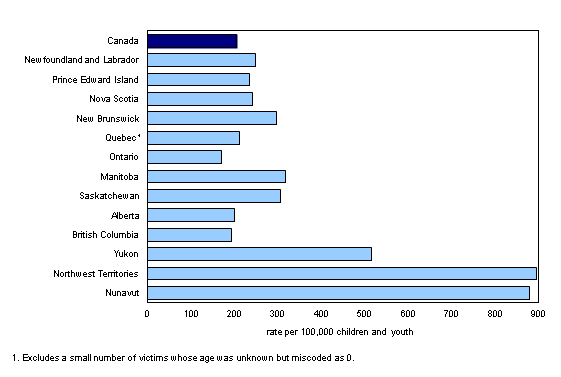Police-reported sexual offences against children and youth in Canada, 2012
Archived Content
Information identified as archived is provided for reference, research or recordkeeping purposes. It is not subject to the Government of Canada Web Standards and has not been altered or updated since it was archived. Please "contact us" to request a format other than those available.
Released: 2014-05-28
There were about 14,000 children and youth (under the age of 18) who were victims of a police-reported sexual offence in Canada in 2012. This represented a rate of 205 for every 100,000 children and youth. Overall, the rate of police-reported sexual offences against children and youth decreased for the second consecutive year in 2012, and was similar to the rate reported by police in 2009.
Nevertheless, children and youth continued to account for more than half (55%) of the victims of sexual offences reported by police, even though they make up 20% of the Canadian population. Police classified about three in four (72%) of these victims as victims of level 1 sexual assault.
Female children and youth were victims of police-reported sexual offences at a higher rate than male children and youth. There were 341 female child or youth victims of police-reported sexual offences for every 100,000 female children and youth in Canada, about five times higher than the rate for males (75 per 100,000 male children and youth).
Manitoba and Saskatchewan have highest provincial rates of police-reported sexual offences against children and youth
Similar to trends in crime in general, the highest rates of police-reported sexual offences against children and youth were recorded in Manitoba (316 per 100,000 children and youth) and Saskatchewan (306 per 100,000).
Rates for these provinces were largely driven by their high rates of sexual offences against girls. For every 100,000 female children and youth in Manitoba, there were 541 police-reported victims of sexual offences. In Saskatchewan, the rate was 528 per 100,000 female children and youth. New Brunswick and Nova Scotia had the highest rates of sexual offences against boys among the provinces (134 per 100,000 male children and youth and 103 per 100,000 male children and youth, respectively).
Saguenay census metropolitan area has highest rate of police-reported sexual offences against children and youth
The Quebec census metropolitan area (CMA) of Saguenay reported the highest rate of sexual offences against children and youth (523 per 100,000 children and youth) among Canadian CMAs in 2012. It was followed by Kingston (350 per 100,000) and Moncton (312 per 100,000).
Rates of police-reported sexual offences against children and youth were about twice as high in non-CMA areas than in CMA areas. Police in non-CMA areas reported 301 child and youth victims per 100,000 population compared with a rate of 159 reported by police within a CMA.
Most persons accused of sexual offences against children and youth are known to the victim
About 9 in 10 (88%) victims knew the accused and for the remainder (12%) the accused was a stranger. Most often, the victim knew the accused as an acquaintance (44%) or a family member (38%). For some victims, particularly older youth, the perpetrator was an intimate partner such as a boyfriend or girlfriend (6%).
Younger children were most often victimized by a family member, while older children were most frequently victimized by an acquaintance or stranger. For two-thirds (66%) of victims aged 0 to 3 years, a family member was identified by police as the perpetrator. In contrast, among victims aged 16 or 17 years, a family member accounted for 19% of perpetrators, while over half (53%) of perpetrators were acquaintances and a further 8% were intimate partners.
Many sexual offences against children and youth involve delayed reporting to the police
When compared with other violent offences, sexual offences against children and youth are more likely to involve a delay in coming to the attention of police. Approximately one-quarter (26%) of all sexual offences against children or youth reported to police in 2012 occurred in previous years.
In contrast, 9% of sexual offences against adults resulted in a delay in reporting. For non-sexual violent violations, less than 1% were delayed in coming to the attention of police, regardless of whether the incident involved an adult or child or youth victim.
Note to readers
This release is based on a Juristat article that presents information on police-reported sexual offences against children at the national, provincial/territorial and census metropolitan area levels. Characteristics of victims, accused persons and incidents are also analyzed. Data are drawn from the Incident-based Uniform Crime Reporting Survey, the Homicide Survey, and the Integrated Criminal Court Survey. For these types of violations, the comparability of police-reported data across jurisdictions and over time may be influenced by levels of reporting to police, as well as single incidents that include several victims.
Trend analysis of Incident-based Uniform Crime Reporting Survey data is limited to the time period from 2009 to 2012 as a result of differences in survey coverage in previous years. Since 2009, the Uniform Crime Reporting Survey Trend database represents police services covering 99% of the population of Canada.
The sexual offences in this release include aggravated sexual assault (level 3), sexual assault with a weapon or causing bodily harm (level 2), sexual assault (level 1), sexual interference, invitation to sexual touching, sexual exploitation, sexual exploitation of a person with a disability, incest, corrupting children, making sexually explicit material available to children, luring a child via a computer / agreement or arrangement, anal intercourse, bestiality (commit/compel/incite) and voyeurism. Data include victims under the age of 18 only.
The Juristat article "Police-reported sexual offences against children and youth in Canada, 2012" (Catalogue number85-002-X) is now available. From the Browse by key resource module of our website under Publications, choose All subjects, then Crime and justice, and Juristat.
Contact information
For more information, or to enquire about the concepts, methods or data quality of this release, contact us (toll-free 1-800-263-1136; 514-283-8300; infostats@statcan.gc.ca) or Media Relations (613-951-4636; statcan.mediahotline-ligneinfomedias.statcan@canada.ca).
- Date modified:


